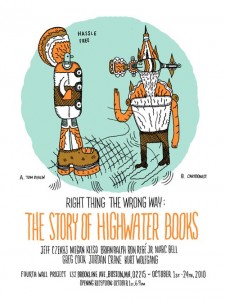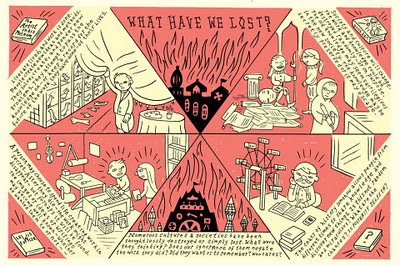Highwater Everywhere
by T. Hodler
Thursday, September 30, 2010
Read Comments (2)
 For those following along with the Highwater oral history, two prominent figures have weighed in with their own reflections: Peggy Burns and Kurt Busiek.
For those following along with the Highwater oral history, two prominent figures have weighed in with their own reflections: Peggy Burns and Kurt Busiek.
[via]





 For those following along with the Highwater oral history, two prominent figures have weighed in with their own reflections: Peggy Burns and Kurt Busiek.
For those following along with the Highwater oral history, two prominent figures have weighed in with their own reflections: Peggy Burns and Kurt Busiek.
[via]
Let’s see if we can put that theory to rest.
But first, a quotation:
In the course of the last fifty years the painters who freed themselves from the necessity of representation discovered wholly new fields of form-construction and expression (including new forms of imaginative representation) which entailed a new attitude to art itself. The artist came to believe that what was essential in art—given the diversity of themes or motifs—were two universal requirements: that every work of art has an individual order or coherence, a quality of unity and necessity in its structure regardless of the the kind of forms used; and, second, that the forms and colors chosen have a decided expressive physiognomy, that they speak to us as a feeling-charged whole, through the intrinsic power of colors and lines, rather than through the imaging of facial expressions, gestures and bodily movements, although these are not necessarily excluded—for they are also forms.
That view made possible the appreciation of many kinds of old art, and of the arts of distant peoples—primitive, historic, colonial, Asiatic and African, as well as European—arts which had not been accessible in spirit because it was thought that true art had to show a degree of conformity to nature and a mastery of representation which had developed for the most part in the West. The change in art dethroned not only representation as a necessary requirement but also a particular standard of decorum or restraint in expression which had excluded certain domains and intensities of feeling. The notion of the humanity of art was immensely widened. Many kinds of drawing, painting, sculpture and architecture, formerly ignored or judged inartistic, were seen as existing on the same plane of human creativeness and expression as “civilized” Western art. That would not have happened, I believe, without the revolution in modern painting. [Italics mine.]
That can be found in Meyer Schapiro’s 1957 essay, “Recent Abstract Painting”, collected in his Modern Art: 19th and 20th Centuries.
It’s a common tactic of comics apologists to refer to comic strips as inherently “modernist,” but while that’s usually good for provoking solemn nods of satisfied agreement from fellow travelers, I’ve never really understood just what is meant by the claim. It strikes me that Schapiro may here point to a possible answer (or at least the kernel of one), and that, say, Picasso’s fondness for Rudolph Dirks’s Katzenjammer Kids might spring from the same source that led to his appreciation of African sculpture. (more…)
For Nerds’ Eyes Only
Reading Comics: How Graphic Novels Work and What They Mean
Douglas Wolk
Da Capo Press, $22.95Even now, with comic books and “graphic novels” finally cracking through the art/literary establishment glass ceiling, you can count the number of intelligent, knowledgeable American comics critics who actually know how to write on two hands (maybe add a foot in there, too, if you’re feeling generous). In any fair version of that list, Douglas Wolk would certainly be one of the fingers or toes. Unlike a lot of writers about comics, Wolk is a professional, meaning he gets paid to write, and he writes about comics because he wants to, not because it’s all he knows; he’s not just an entitled fan who feels the need to tell you the long, sorry, and interminable story of how sad he is that he doesn’t like reading Sandman as much as he did when he was thirteen years old. (more…)
I’ve started to wonder whether what I read as a child wasn’t more important. […] And then there was Pif le chien, a comic book published by Editions Vaillant and sponsored by the Communist Party. I realize now when I reread it that there was a Communist bent to many of Pif’s adventures. For example, a prehistoric man would bring down the local sorcerer in single combat and explain to the tribe that they didn’t need a sorcerer and that there was no need to fear thunder. The series was very innovative and of exceptional quality.
—French novelist Michel Houellebecq, interviewed in The Paris Review No. 194
Exceptional one-person comic strips like “Little Nemo,” “Krazy Kat,” and “Peanuts” were among the first to be championed as high art partly because standard industry practices such as “ghosting” and assembly-line production obscure idiosyncrasies, freeze evolution, and desiccate scholarly and fannish narratives. Our impulse to uncover a human source — to project from reproducible artifact to traceable performer, so that we might begin to speak of cinematographer “John Alton” as we would of “Humphrey Bogart” — isn’t just a taxonomic convenience. It also reflects frustrated feelings of gratitude and intimacy, as evidenced by the career of Walt Disney comics artist and writer Carl Barks. Although Barks wrote, drew, and inked his own work for decades, his employer blocked fan mail and withheld contributor credits on the theory that sales would decline if children thought anyone other than Walt Disney was involved in the comic books. As a result, Barks wasn’t successfully contacted by readers until 1960, and his first interview (conducted in 1962) was only allowed publication in 1968. Given no clues other than style, loyal fans identified and collected Barks as “The Duck Artist,” “The Good Duck Artist,” or simply “The Good Artist,” the last eventually inscribed on his gravestone.
—From “High, Low, and Lethem”, a just-posted, confidence-killing essay in which the great Ray Davis takes nearly every subject I’ve written about for Comics Comics over the last five years—from Steve Gerber and Carl Barks to Jonathan Lethem’s Omega the Unknown and the auteur theory’s connection to comics, among others—and writes something actually worthwhile, intelligent, and stylish about them. He shows me up as a lazy halfwit actually. The funny thing is that I’m fairly certain he’s never heard of me or Comics Comics at all, and the confluence of thought is purely coincidental. Oh well, I guess I need to try harder.
1. New Richard Sala site.
2. The kind of readers who frequent this site have probably already seen this, but if not, you really should check out Daniel Raeburn’s website. Last week, he posted free pdfs of all four issues of The Imp, which includes an unfairly large proportion of the best and most insightful comics criticism of the last fifteen years. This is essential reading.
3. New Matthew Thurber site.
4. David Bordwell delivers a typically meaty essay on the downsides of episodic, serialized entertainment, focusing mainly on the prime delivery method for the highest grade junk of this type: television.
Having been lured by intriguing people more or less like us, you keep watching. Once you’re committed, however, there is trouble on the horizon. There are two possible outcomes. The series keeps up its quality and maintains your loyalty and offers you years of enjoyment. Then it is canceled. This is outrageous. You have lost some friends. Alternatively, the series declines in quality, and this makes you unhappy. You may drift away. Either way, your devotion has been spit upon.
It’s true that there is a third possibility. You might die before the series ends. How comforting is that?
With film you’re in and you’re out and you go on with your life. TV is like a long relationship that ends abruptly or wistfully. One way or another, TV will break your heart.
Incidentally, along the way, he quotes the late, great Gilbert Seldes (best known to funny-page aficionados for his seminal essay on Krazy Kat).
But the main interest here for comics readers, or course, is that, at least here in America, their medium of choice is the second most popular purveyor of long-lived serial entertainment. Though with comics the heart-breaking potential is even greater. From Blondie and Gasoline Alley to Batman and Spider-Man, a surprising number of ancient titles are still around, potentially offering a lifetime of fiction featuring the exact same characters. (That the recent cancellations of strips such as Cathy and Little Orphan Annie have received so much attention is testament to how rarely such cash cows are allowed to expire.)
It is sometimes fun to wonder what it might be like if television was run like the comics industry — would The Beverly Hillbillies still be on the air, with its fifth cast, rei-magined to exude a “grim and gritty” atmosphere? I guess Dallas was sort of like that… And then there’s Star Trek. And 90210. Ah, maybe this isn’t so much fun to think about after all. The Bordwell essay’s still worthwhile.

5. Finally, I like it when Sammy Harkham writes about comics. He does it too rarely. Last month, he published a short but sweet post on artist and beermonger Ron Regé. This led to an interesting exchange in the comments about the practice of constructing comics stories out of a collection of smaller, interconnected strips (e.g. Ice Haven, much of David Heatley’s work, Wimbledon Green). One particular anonymous commenter was very much against the practice, considering it a trendy cheat, doomed to appear as dated in the future as ’90s-era CGI “morphing” does today (my analogy, not his/hers).
Derik Badman draws attention to two previous posts worth reading on the subject, written by Charles Hatfield and Craig Fischer.
I end up on the boring but correctly neutral side of another anonymous commenter in that thread—”Who cares if it is a trendo or a gimmick?”—but I really do enjoy the effect of this kind of comics “mosaic” when it’s done right. And generally, even when an artistic technique is considered newfangled, gimmicky, or showoffy, there’s a good chance it has actually been around for a long time. (See Steven Moore’s recent The Novel: An Alternate History, for an entertaining recounting of a few millennia worth of examples of literary postmodernism, all somehow predating capital-M Modernism by centuries.) And this same phenomenon seems to be true in this discussion as well. One name in particular that doesn’t seem to be coming up yet (unless I missed it) is John Stanley. In fact, a big part of the enjoyment for me of reading his Melvin Monster and (especially) Thirteen Going on Eighteen books has come from the inventive and surprising ways in which he builds his issues through combining standalone stories. I am sure there are many more (and better) examples of pre-’90s and ’00s cartoonists doing this kind of thing, but my main point is simply that nothing new exists under the sun, a clichéd insight that’s been repeated by about a million morons like myself, probably since well before it appeared in Ecclesiastes. Let me say it once more for old time’s sake.

The panel used as an illustration in the original New Guard article. From Tales to Astonish #60; written by Stan Lee, penciled by Dick Ayers, inked by Paul Reinman.
Bigger than the Birch Society, YAF and the Americans for Constitutional Action all rolled into one, there has recently emerged on the contemporary scene a new potentially right-wing organization of formidable power—the Merry Marvel Marching Society. This extremist group, cleverly disguised as an innocent venture in comic-book publishing, is busily undermining the minds of our nation’s youth and indoctrinating them in a set of beliefs which can only be described as patriotic and wholesome. As Perry White of the old Superman comics would say—“Great Caesar’s Ghost!” What is the world coming to?
Yes, unbeknownst to the Liberal Press, the minds and hearts of America’s college youth are being subtly spirited away by a group of tongue-in-cheek artists and writers in New York City.
Thanks again to the indefatigable researches of Sean Howe, another historical oddity has been drawn to our attention: a 1966 piece on the (admirable, in the author’s view) right-wing subtext of Marvel Comics. It was originally published in The New Guard, the official publication of the Young Americans for Freedom, and the author, David Nolan, went on to co-found the Libertarian Party and is currently campaigning for a senate seat in Arizona.
This is interesting from multiple angles, whether considered in the context of Marvel legend Jack Kirby’s JFK liberalism, Alan Moore’s condemnation of superhero comics as connected to American militarism, or the current climate of “realistic” superhero comics—to name just a few possibilities.
The full article can be read after the jump. (more…)
UPDATE: The giant pen is fully funded!

This isn’t normally the kind of thing we do here on Comics Comics, but there are less than 36 hours left for the great Jim Woodring to raise funds for an exciting project, and we would be remiss if we didn’t let our readers know about it.
More information can be found here. At the very least, watch the video, and pass the news along to anyone you know who might be interested. Thanks.
Welcome to the preseason for 2010’s Comics Comics Comic-Book Club, which will feature a discussion of Alan Moore and Jacen Burrows’s new series Neonomicon. Before getting to that, though, it probably makes sense to start with Alan Moore’s The Courtyard, the 2003 two-issue miniseries to which Neonomicon is a sequel.
Garth Ennis, of Preacher and Punisher fame, introduces the comic with some effusive praise:
Here he is now with his latest effort, ably assisted by Antony Johnston and drawn by the always excellent Jacen Burrows: Alan Moore’s The Courtyard. And yes, it’s brilliant, and yes- sob– he’s as good as he ever was, but what The Courtyard really does is confirm the effortless quality of the man’s talent. A story bursting with ideas and characters and nice lines and spooky twists, enough to keep most writers occupied for a couple of years—but where just about anyone else would stripmine a concept like this to death, what does Alan devote to it? Forty-eight pages, no more.
Actually, Moore actually didn’t even devote that many pages to the concept, because Moore is not in fact the author of this comic (more…)